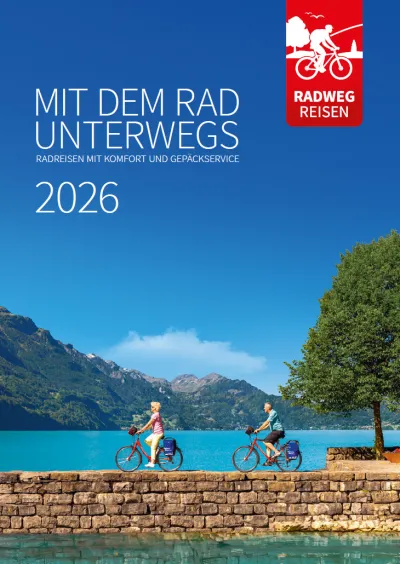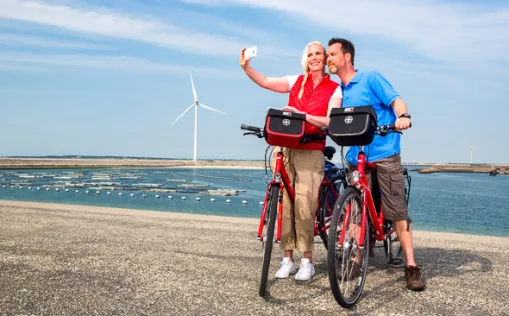

Travel report: 250 kilometers on the Atlantic - our Portugal adventure
From our guests Dorothea, Leo and Theresa

Stage 1:
We started in summery Setúbal, where we spent a night in a chic design hotel and explored the pretty old town and restaurants. The bike handover with Luis was quick and easy with really light and well-maintained bikes. The next morning we took the ferry across the Saldo River to the Tróia Peninsula, which is lined with miles of sandy beaches. We made a detour to Praia Tróia Mar and then set off on the actual stage of around 65 kilometers to Vila Nova de Santo André. The route through the Alentejo region was lined with sleepy villages, where a pair of storks nests on every electricity pylon. We also passed beautiful green rice fields that you wouldn't expect to see in Europe.
Show more Show less
Stage 2:
The next day, we continued on to Vila Nova de Milfontes. The route began adventurously on the hard shoulder of the highway and led to the horseshoe-shaped bay of Sines, a coastal town that made history as the birthplace of the navigator Vasco da Gama, but is also characterized by industry. The Castelo, which towers high above the city, is well worth a detour.
We continued along an impressive stretch of coastline to Porto Covo, where you should definitely stop for a swim in the turquoise Atlantic water at one of the countless bays! In Sines, the traffic is still particularly heavy and we were maltreated with very reckless overtaking maneuvers by buses and trucks. However, as soon as the route changed to quiet side roads, things became more relaxed.
Show more Show less

This was followed by a stretch along a sandy track past the Ilha do Pessegueiro, the view at sunset was truly stunning. Tired but happy, we arrived in Vila Nova de Milfontes and took a break the next day, which we spent mainly on the roof terrace of the pretty old town hotel. For the rest of the trip, we had planned a rest day after each of the 50 to 60-kilometer stages, which was necessary for physical regeneration and also gave us the opportunity to get to know the places better (and the seafood! Portugal's cuisine is a dream). We had opted for normal trekking bikes for the trip and were therefore able to feel every meter of altitude. If you don't want to exert yourself too much, you should opt for an e-bike in Portugal and can certainly complete the 250-kilometer route to the Algarve more quickly. Navigating south was easy thanks to the GPS device and maps, and we hardly got lost (only in the towns did we need to pay more attention) as long as we kept to Luis' motto: "The ocean has to be on the right side!" If you want to sweat less, you should do the route in spring or early summer rather than in the height of summer. It's still doable if you always have enough water with you. We had plenty of sunshine during the entire trip!
Show more Show less
Stage 3:
The following day took us to Cabo Sardão, the westernmost point of the Alentejo region - a magical place with high cliffs and a lonely lighthouse. We were particularly pleased when we discovered the storks nesting on the cliffs, sailing calmly to their nests, unperturbed by the wind and waves. Unique in the world! In the afternoon, after a rollercoaster ride down to the bay, we stopped at Praia do Carvalhal and jumped into the roaring waves of the ice-cold Atlantic. With its good infrastructure and location between steep cliffs, the beach is definitely worth a visit!
Show more Show less

We continued steeply uphill on a plateau to the Rio de Seixe, which winds its way past wide fields to the sea. The river also marks the border between the Alentejo region and the Algarve, which we had happily reached. Once we arrived in Odeceixe, we climbed steeply (in the truest sense of the word) to the highest point of the village, where our well-earned accommodation was hidden behind the historic mill in old whitewashed houses. Another rest day (a hike to Praia de Odeceixe is definitely worthwhile!) and we continued on to the penultimate stage to Pedralva.
Show more Show less

Stage 4:
On the way, we climbed the castle hill of Aljezur, which offered a panoramic view over the vast landscape as far as the Atlantic. This was followed by 25 long kilometers through a godforsaken and arid plain full of ups and downs. Tired, we reached Carrapateira, where we were able to watch the surfers at Praia da Bordeira and cycle along the breathtaking stretch of coast to Praia do Amado. Those who still had energy left braced themselves for the last climb of the day to Pedralva! This is a charming little village tucked away in a mountain hollow. Formerly abandoned, it has been lovingly restored and now offers pretty vacation cottages with vintage furniture and a first-class restaurant. A perfect place to spend a day recovering from cycling.
Show more Show less



Stage 5:
The next day, we set off on the final stage to Sagres. The serpentine bends out of Pedralva were a real challenge. Via a gravel road and an even steeper slope, we soon reached Praia da Barriga, a beach as beautiful and full of sea mist as if it were out of this world. There we took a shortcut to the neighboring beach. As the tide was low, we were able to push the bikes. But we still got stuck in the sand! This was followed by a steep climb to Vila do Bispo and a final section along a deserted and windswept plain to Cabo de São Vicente. We made it!
Show more Show less


We had covered over 250 kilometers and climbed more than 2500 metres since leaving Setúbal and enjoyed the view from the most south-westerly point in Europe and the cliffs lapped by the Atlantic. We were looking forward to the next few days of well-deserved relaxation in Sagres before taking the train back to Lisbon. We are still very excited about our Portugal adventure and could hardly tear ourselves away!
Show more Show less








